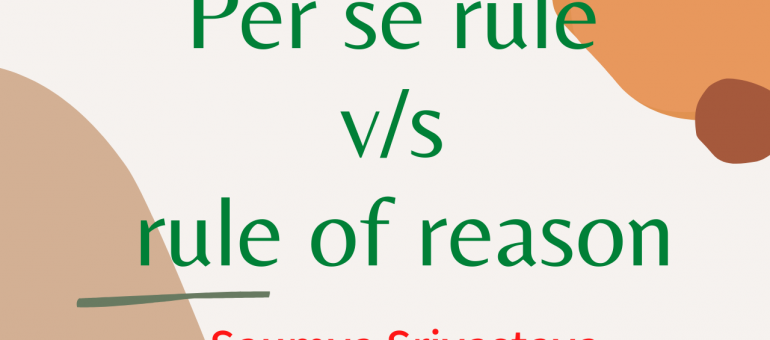Per se rule v/s Rule of Reason
Table of Contents
What is a Per Se Rule?
Firstly, within side the class, after completing the vertical agreements under Section 3(4) of the Competition Act, 2002, Per Se Rule became taught. Per Se Rule is actually whilst one individual on whom are the offences or the allegations which pertain to a particular problem is claimed in the front of any Court of Law, such alleged individual has the onus to show that such allegation is a falsified one. In
normal cases, need to there be an allegation filed in opposition to a individual, the Courts could call for conclusive proof to show and maintain the accusation as admitted. In those cases, the accused individual want now no longer show some thing until some form of conclusive evidence is held in opposition to them. Wherein, within side the Per Se Rule, the accused individual, from the instant of alleging, the weight to say innocence falls on them. This rule might be hired best within side the horizontal agreements as admitted below Section 3(3) of the Competition Act, 2002. This is likewise known as the Rule of Presumption because the defendant birthday celebration should show that there’s no such preparations made via way of means of them within side the first place.
Rule of Reason
The rule of reason is precisely contrary to the Per Se Rule, that is, the informant holds the onus of proving the statistics alleged by them or any anti-competitive agreement claimed by them. Section 3 (1) of the act may reason or possibly may also reason an considerable damaging effect. The motive being the utility of Rule of Reason wherein the onus at the informant to show the facts, it reasons an considerable damaging effect, as there’s the preponderance of chance as implemented via way of means of the Competition Commission of India. So, in Section 3 (1), Rule of Reason is implemented and now no longer Per Se Rule. Similarly, in Section 3 (4), within side the vertical agreements, as there are exceptional degrees or tiers or manufacturing chain, it is able to reason an considerable damaging effect. Consequently, the Rule of Reason is implemented. Differentiating Between the Horizontal and Vertical Agreements There is a great line distinction among the horizontal agreements and the vertical agreements. If there may be an different settlement among merchandise that determine to promote
together exclusively, will this be cartel? For example, PVR Cinemas and Coca Cola input into an settlement to promote Coca Cola and its related drinks in PVR premises. Would this represent a opposition problem because the commercial enterprise of different comparable
corporations are being confined or a patron problem because the customer’s proper to pick comparable corporations’ merchandise is being fettered? The solution to this will be to check the stages of the similar marketplace of the 2 merchandise. Cinema marketplace is absolutely
inappropriate to the beverage marketplace. One’s presence will now no longer have an effect on the opposite. So, those specific degree marketplace gamers be part of fingers to give each in their merchandise to shape one experience. So, this qualifies beneathneath Section 3 (4)
and as a consequence for all of us claiming in opposition to those problems can have the onus to show the accusation. This turned into the case in Shamsher Kataria v. Honda. Thus, the Rule of Reason is applied. Similarly, within side the case of a provisional store chain like 7-
Eleven can not comply with promote Coca Cola merchandise by myself as his marketplace is to promote well-known items because the customers desire to buy and there must be no restriction felled at that end. Therefore beneath Neath Section 3 (3), if such agreements show
up and a person turns into an informant, then the opposite character holds the onus to show the accusation wrong, that is, Per Se Rule is applied.
Understanding Cartel
Unlike the vertical agreements, the agreements made via way of means of the equal level of players of a marketplace, it turns into unlawful and is called as the Cartel. There is a trendy presumption that the horizontal agreements are per se wrong however it's far rebuttable. Not each horizontal settlement qualifies as cartel. Citing instance to the WB Film Producers’ Case, wherein the consortium of contributors of the neighborhood TA, seek advice from and announce that simplest neighborhood made serials could be telecasted however now no
longer another language serials which generally have better call for. This turned into in purpose to defend the nearby manufacturers and sell language-primarily based totally serials. This does now no longer qualify as cartel. If there may be an settlement made via way of means of players of the marketplace who take a seat down within side the equal chain, that is, if the goods are comparable however now no
longer identical, then such agreements are horizontal agreements and are illegal beneath Neath Section 3 (3). Examples might be, if the onion wholesale sellers of 1 equal marketplace discreetly agree amongst themselves to maintain the onions for a while, in order that the call for the onions might increase, thereby in the end growing their fee, then that is unlawful to do so.
Sometimes comparable pricing among players to decide the marketplace fee also can be taken into consideration beneath Neath this. Such settlement want now no longer be in writing however mere information of events will suffice to qualify as cartel. So there want now no
longer be any purpose for the informant to show however it falls on the alternative person.
Inter-caste marriages in India : Know Marriage Scheme/Law, Hindu & Special Marriage Act
Like and Follow us on :
Facebook Twitter Instagram LinkedIn

